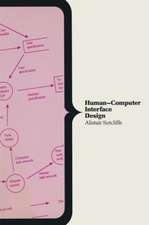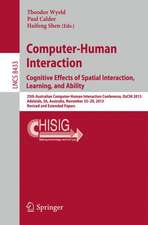(Re)Searching the Digital Bauhaus: Human–Computer Interaction Series
Editat de Thomas Binder, Jonas Löwgren, Lone Malmborgen Limba Engleză Paperback – 28 noi 2014
| Toate formatele și edițiile | Preț | Express |
|---|---|---|
| Paperback (1) | 991.27 lei 6-8 săpt. | |
| SPRINGER LONDON – 28 noi 2014 | 991.27 lei 6-8 săpt. | |
| Hardback (1) | 999.02 lei 6-8 săpt. | |
| SPRINGER LONDON – 27 noi 2008 | 999.02 lei 6-8 săpt. |
Din seria Human–Computer Interaction Series
- 20%
 Preț: 655.85 lei
Preț: 655.85 lei - 20%
 Preț: 309.25 lei
Preț: 309.25 lei - 20%
 Preț: 375.54 lei
Preț: 375.54 lei - 20%
 Preț: 644.48 lei
Preț: 644.48 lei - 20%
 Preț: 667.75 lei
Preț: 667.75 lei - 20%
 Preț: 664.44 lei
Preț: 664.44 lei - 20%
 Preț: 1164.84 lei
Preț: 1164.84 lei - 20%
 Preț: 817.55 lei
Preț: 817.55 lei - 20%
 Preț: 657.16 lei
Preț: 657.16 lei - 20%
 Preț: 645.31 lei
Preț: 645.31 lei - 20%
 Preț: 938.66 lei
Preț: 938.66 lei - 15%
 Preț: 658.05 lei
Preț: 658.05 lei - 20%
 Preț: 822.51 lei
Preț: 822.51 lei - 20%
 Preț: 654.21 lei
Preț: 654.21 lei - 20%
 Preț: 994.26 lei
Preț: 994.26 lei - 20%
 Preț: 1621.89 lei
Preț: 1621.89 lei - 20%
 Preț: 991.60 lei
Preț: 991.60 lei - 20%
 Preț: 783.45 lei
Preț: 783.45 lei - 20%
 Preț: 1175.42 lei
Preț: 1175.42 lei - 20%
 Preț: 659.97 lei
Preț: 659.97 lei - 20%
 Preț: 219.15 lei
Preț: 219.15 lei - 20%
 Preț: 334.86 lei
Preț: 334.86 lei - 20%
 Preț: 969.84 lei
Preț: 969.84 lei - 20%
 Preț: 642.19 lei
Preț: 642.19 lei - 20%
 Preț: 314.39 lei
Preț: 314.39 lei - 20%
 Preț: 661.14 lei
Preț: 661.14 lei - 20%
 Preț: 995.89 lei
Preț: 995.89 lei - 20%
 Preț: 752.58 lei
Preț: 752.58 lei - 20%
 Preț: 990.30 lei
Preț: 990.30 lei - 20%
 Preț: 990.12 lei
Preț: 990.12 lei - 20%
 Preț: 336.21 lei
Preț: 336.21 lei - 20%
 Preț: 334.71 lei
Preț: 334.71 lei - 20%
 Preț: 312.62 lei
Preț: 312.62 lei - 20%
 Preț: 994.92 lei
Preț: 994.92 lei - 20%
 Preț: 331.74 lei
Preț: 331.74 lei - 20%
 Preț: 646.80 lei
Preț: 646.80 lei - 20%
 Preț: 334.86 lei
Preț: 334.86 lei - 20%
 Preț: 994.40 lei
Preț: 994.40 lei - 20%
 Preț: 329.76 lei
Preț: 329.76 lei - 20%
 Preț: 332.24 lei
Preț: 332.24 lei - 20%
 Preț: 992.11 lei
Preț: 992.11 lei - 20%
 Preț: 650.40 lei
Preț: 650.40 lei - 20%
 Preț: 337.00 lei
Preț: 337.00 lei - 20%
 Preț: 332.39 lei
Preț: 332.39 lei - 20%
 Preț: 1279.86 lei
Preț: 1279.86 lei - 15%
 Preț: 636.12 lei
Preț: 636.12 lei - 20%
 Preț: 336.67 lei
Preț: 336.67 lei - 20%
 Preț: 1000.70 lei
Preț: 1000.70 lei - 20%
 Preț: 645.14 lei
Preț: 645.14 lei
Preț: 991.27 lei
Preț vechi: 1239.09 lei
-20% Nou
Puncte Express: 1487
Preț estimativ în valută:
189.68€ • 198.45$ • 157.57£
189.68€ • 198.45$ • 157.57£
Carte tipărită la comandă
Livrare economică 03-17 aprilie
Preluare comenzi: 021 569.72.76
Specificații
ISBN-13: 9781447158219
ISBN-10: 1447158210
Pagini: 384
Ilustrații: IX, 371 p.
Dimensiuni: 155 x 235 x 20 mm
Greutate: 0.54 kg
Ediția:2009
Editura: SPRINGER LONDON
Colecția Springer
Seria Human–Computer Interaction Series
Locul publicării:London, United Kingdom
ISBN-10: 1447158210
Pagini: 384
Ilustrații: IX, 371 p.
Dimensiuni: 155 x 235 x 20 mm
Greutate: 0.54 kg
Ediția:2009
Editura: SPRINGER LONDON
Colecția Springer
Seria Human–Computer Interaction Series
Locul publicării:London, United Kingdom
Public țintă
ResearchCuprins
Introduction: (Re-)Programming Interaction Design.- From Utopia 1981 to Utopia 2008.- HCI and Design: Uncomfortable Bedfellows?.- Constructing Utopia(s) in Situ: Daring to be Different.- Tradition and Transcendence.- Designing From Somewhere: A Located, Relational and Transformational View of Design.- On Participation and Service Innovation.- The Phenomenological Stance of the Designer.- Designing for Homo Ludens, Still.- Gaming Literacy: Game Design as a Model for Literacy in the 21st Century.- Distruptions.- On a Scale Between Art and Design : On the Aesthetics of Function From the Bauhaus Until Today.- Appropriating Digital Environments - (re-)Constructing the Physical Through the Digital.- Designed Animism.- In Search of a Critical Stance.- A Science of the Possible: A New Practice in the Spirit of Bauhaus.- Work, Design, Computers, Artifacts.- The Everyday Poetics of a Digital Bauhaus.
Notă biografică
Thomas Binder is a design researcher and educator working with design students and industry to develop novel approaches to collaborative design and participatory methods to the study of the changing everyday of potential users.
Jonas Lowgren is an interaction designer with twenty years of experience from academia and industry. His research at Malmo University is focused on cross-media products, interactive visualizations and the design theory of digital materials.
Lone Malmborg is currently an Associate Professor of interaction design at IT University of Copenhagen. She is a member of the Innovative Communication Group. She has been developing and heading an education program in interaction design at Malmo University, Arts and Communication, and has been establishing and heading the research group Creative Environment.
Jonas Lowgren is an interaction designer with twenty years of experience from academia and industry. His research at Malmo University is focused on cross-media products, interactive visualizations and the design theory of digital materials.
Lone Malmborg is currently an Associate Professor of interaction design at IT University of Copenhagen. She is a member of the Innovative Communication Group. She has been developing and heading an education program in interaction design at Malmo University, Arts and Communication, and has been establishing and heading the research group Creative Environment.
Textul de pe ultima copertă
Where does interaction design come from? What foundations are relevant today? In this book, internationally renowned scholars and designers explore how the avant-garde ambitions of the 1920-30s Bauhaus to re-align new technology with emerging social needs combines with a more contemporary sensitivity to participation and the social creativity inherent in the modern digital design materials.
"These creators of the Digital Bauhaus pose here the key questions for our profession and our society and they offer thought-provoking avenues for each reader to follow."
Terry Winograd, editor of "Bringing Design to Software"
"The papers together explore the possibilities for creating an 'aesthetic-technical production orientation' that recontextualizes technology as skilled practice, as always political, and as best created through sustained engagements among people, and between people and things."
Lucy Suchman, author of "Plans and Situated Action"
"These creators of the Digital Bauhaus pose here the key questions for our profession and our society and they offer thought-provoking avenues for each reader to follow."
Terry Winograd, editor of "Bringing Design to Software"
"The papers together explore the possibilities for creating an 'aesthetic-technical production orientation' that recontextualizes technology as skilled practice, as always political, and as best created through sustained engagements among people, and between people and things."
Lucy Suchman, author of "Plans and Situated Action"
Caracteristici
Outstanding lineup of contributing authors Connections back to the origins of modern design theory






















